Our 15-day visit to the Washington, DC area included revisiting some of
the iconic tourist stops we've seen on previous trips plus touring some
places new to us like Mt. Vernon and the U.S. Capitol Building.
I'd like to think we acquired more knowledge and wisdom from
what we learned and observed. We appreciate culture and history so much
more now than we did when we were school kids.
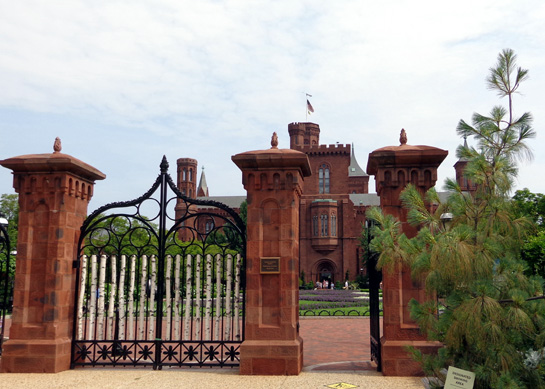
An entrance to the "Castle," the
oldest of the Smithsonian Institution's building
In this entry I'll show photos from some of the museums, memorials,
monuments, and the annual Smithsonian Folklife Festival along the National Mall.
I have so many pictures I want to show you from the U.S.
Botanical Gardens, Mt. Vernon, and a personal tour of the U.S. Capitol
with one of our Representative's staff members that I'll make
separate entries for those places.
THE NATIONAL MALL
Washington, D.C. has shopping malls, of course, but it is world
famous for the National Mall, a beautiful two-mile-long green space
surrounded on both sides by stately Smithsonian Institution museums and
galleries and on the ends
by the formidable U.S. Capitol Building and the Lincoln Memorial. West
of center is the iconic Washington Monument.
Protected and managed by the National Park Service, the full name of
this symbol of our country's freedom is the
National Mall and Memorial Parks.
Here is a teensy map of the very long National Mall; you can
find a readable map at the site above.
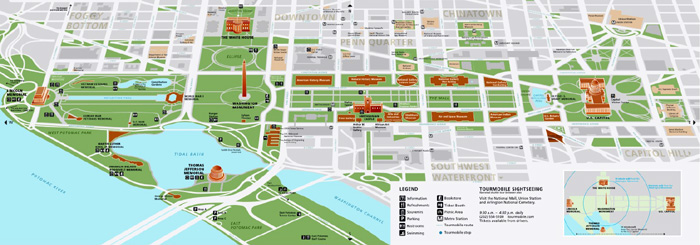
The Mall is a wonderful gathering space for people from all over the
world, particularly when part of the grassy areas aren't fenced off like
they were in the days leading up to the Fourth of July.
This interesting tree west of the Washington Monument wasn't fenced
in:
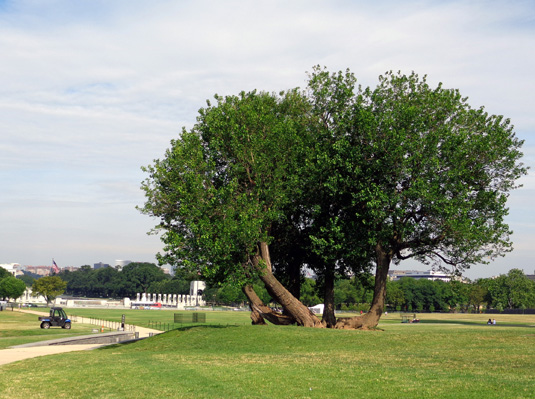
One day we sat in the shade of that tree to eat our lunch. Kids love to
climb on the low branches. The WWII memorial is in the background.
Within the green spaces are scenic water features like duck ponds and the reflecting
pools in front of the Lincoln Memorial and U.S. Capitol Building.
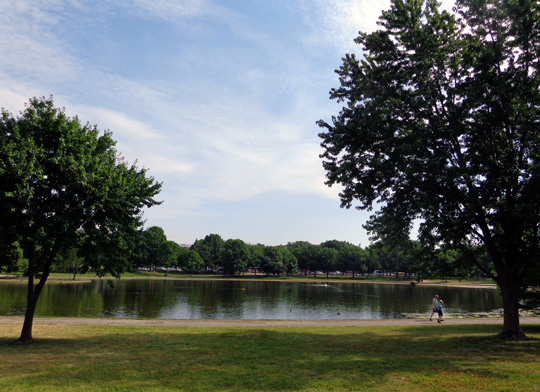
Constitution Gardens area between
the Vietnam and WWII memorials
People love to walk, run, and cycle on the paved paths and streets in
and next to the Mall area.
If you want to see all the buildings and memorials in one day it's at
least a four-mile walk to do a complete rectangle around the perimeter
of the National Mall. That doesn't include going into any of the
buildings. Be prepared with comfortable shoes and plenty of fluids to
drink, especially in the heat of the summer.
Better yet, take several days to explore the area.
Regardless of how much time you take, if you can't walk far enough to see
everything you want to see you can rent a Segway or bicycle, ride a
horse-drawn carriage, or take a bus tour.
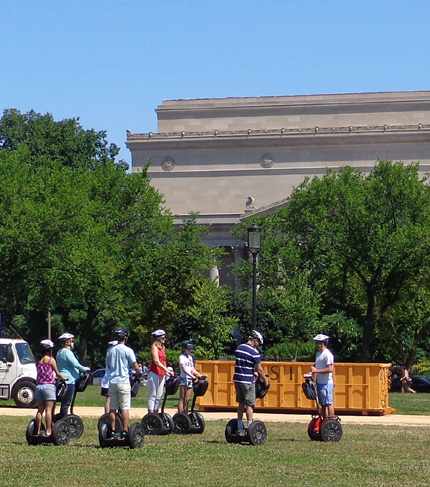
Visitors get a lesson in riding a
Segway
before venturing out to explore
the National Mall.
SMITHSONIAN FOLKLIFE FESTIVAL
One of the activities we enjoyed on the Mall was the 48th annual
Smithsonian Institute Folklife Festival, which ran for several days
before and after July 4.
Several acres in the middle of The Mall were
covered in tents, food booths, and displays.

The Washington Monument pokes up
in the background;
to the right is the dome of the
very popular Natural History Museum.
This year's festival featured the cultures of China and Kenya.
Each country had stages with a succession of different performances that
continued throughout the day (all free), interpretive programs like
story-telling, food booths, and demonstrations
of native crafts.

Kenyan stage with different performances every hour
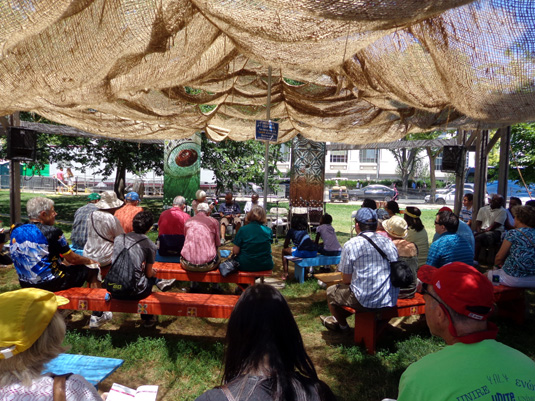
One of the Kenyan interpretive programs
We enjoyed tasting authentic foods and beverages from both
countries, listening to native music and dancing, and watching artisans
making traditional arts and crafts.
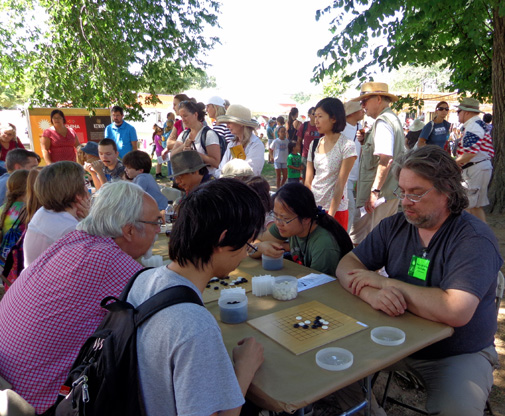
Visitors participate in a Chinese
game
I was particularly interested in the Chinese textiles,
which included quilting and very intricate silk embroidered pictures,
below:


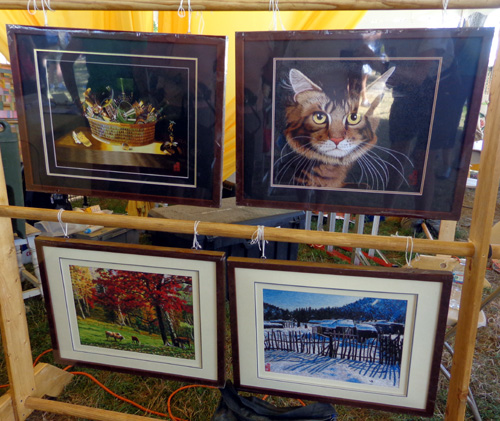
The designs in the photo above looked like photos or
paintings from a few feet away, not embroidery.
The beautiful textile and other craft demonstrations
remind me of all the unfinished projects that are sitting in our storage
unit, including an intricate, half-completed, miniature embroidered silk
Chinese-patterned rug I started when my eyes and fingers were much younger.
The Chinese woman demonstrating the craft in the
festival looked even older than me, so maybe I'll be able to finish my
small project some day!
SMITHSONIAN MUSEUMS
Founded in 1846, the
Smithsonian is the world's largest
museum and research complex, with nineteen museums and galleries, the
National Zoological Park, and nine research facilities. The
institution's mission is to preserve our nation's heritage, discover new
knowledge, and share our resources with the rest of the world.
That's a lofty goal -- and it does it quite well. If we lived
anywhere near Washington, D.C., this is an organization we'd be thrilled
to volunteer for.
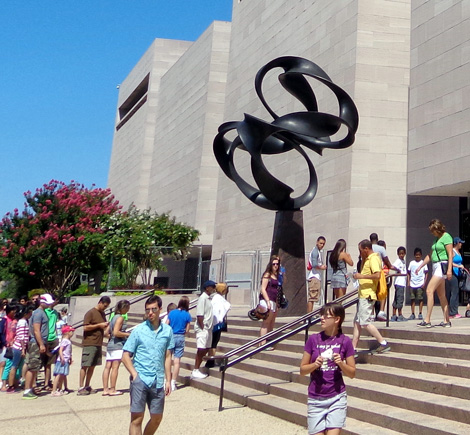
Sculpture outside one of the
entrances to the Air & Space Museum, a very popular
Smithsonian museum. We've seen it
several times and didn't go in this time.
What's most astonishing to me is that U.S. citizens and visitors from
any other country can get into most of the Smithsonian's museums for
free. And a lot of foreign visitors do visit these museums.
I think every person in the USA should visit as many of the museums
and galleries as possible during their lives. There is so
much to learn and observe. Local kids are lucky they can go there on
school trips. Jim and I have been in several of the museums, some more
than once, and we've barely scratched the surface of all there is to see in them.
On this trip we visited the relatively new American Indian Museum,
which opened after our last visit to the city in 2005, and the iconic
American Natural History Museum, which we've visited on all of our
previous trips to Washington, DC.
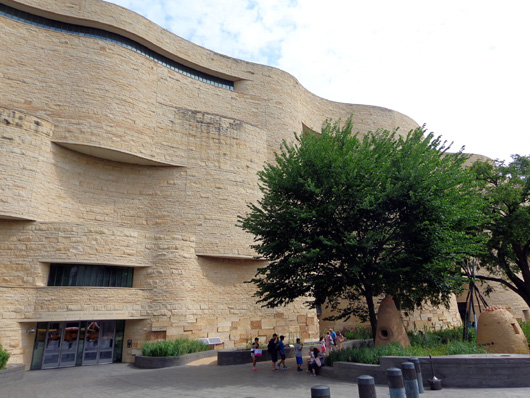
Above and below: several
views of the curvy Native American museum
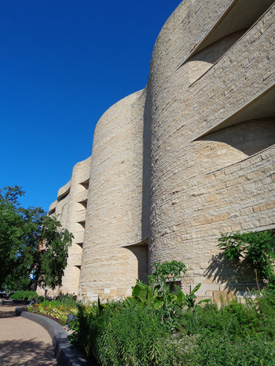
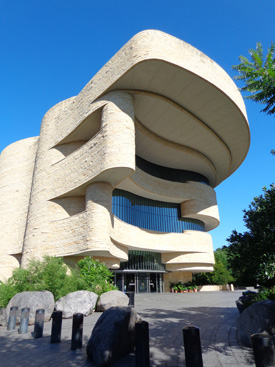
We were inside the American Indian Museum twice in early July. It
wasn't crowded either time, so we could leisurely look at the exhibits.

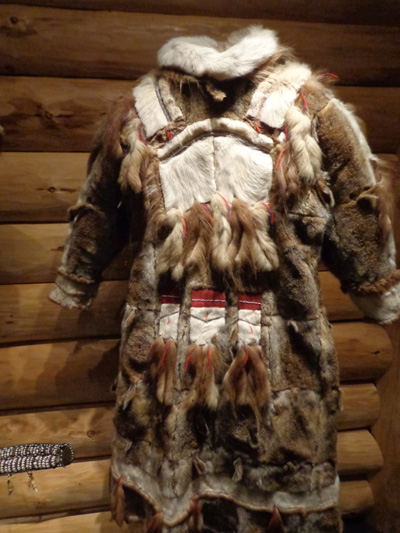
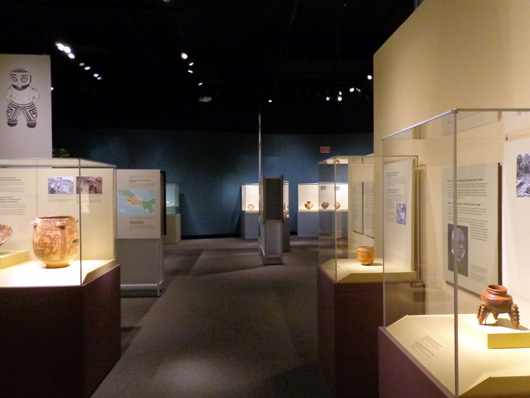
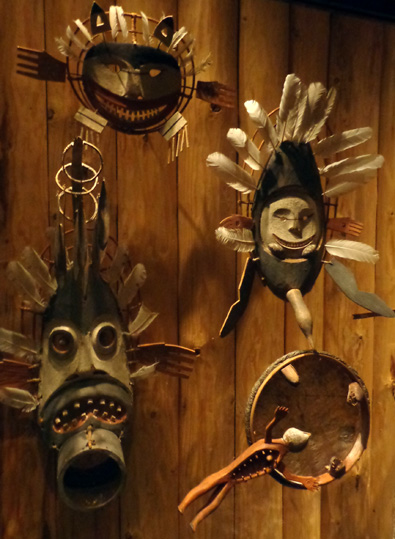
We heard that the ethnic food in its cafe was very good so we had
lunch there one weekday. There was a good selection of soups, salads,
entrees, and desserts from both North and South American Indian
cultures. The prices were moderate and the food was delicious.
The dining area is interesting, with views of a waterfall right
outside the window:
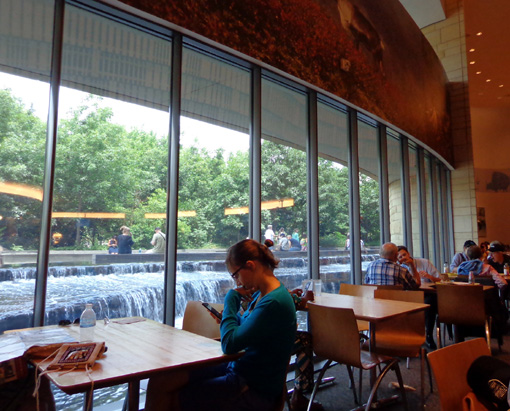
We made a mistake going into the Natural History Museum on July 5. It
was terribly crowded during this holiday weekend and we had some
difficulty moving around and looking at the exhibits in which we were
most interested.
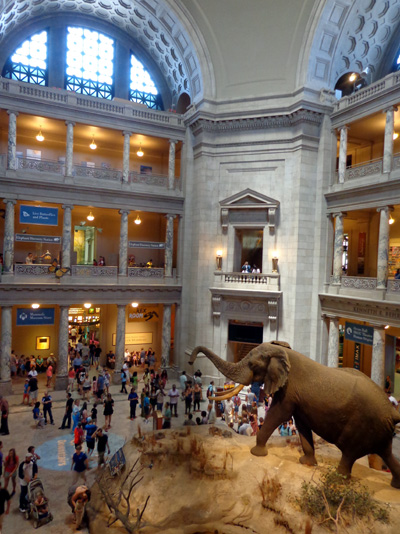
Large mastodon in the lobby of
the three-story museum (plus basement)
It shouldn't surprise anyone that one of my favorite
rooms in this museum has walls full of gorgeous wilderness photos, many
from Alaska.
The photo in the center below is a view of Denali AKA
Mt. McKinley reflected in Wonder Lake:
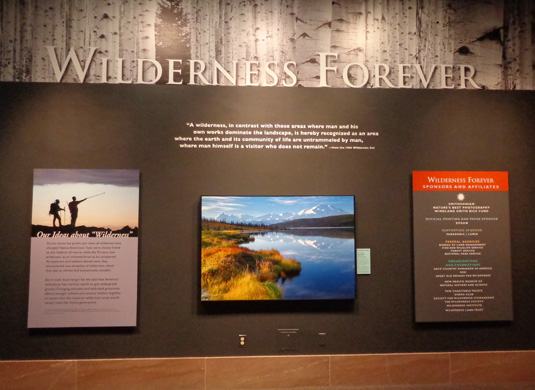
One of my favorite areas in the Natural History Museum
has dozens of glassed-in cases with gorgeous and unusual gems and
minerals from around the U.S. and the world:
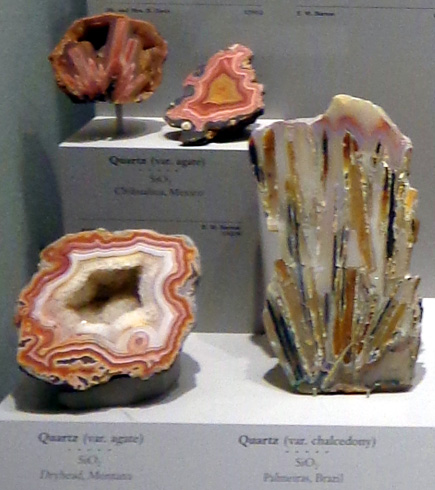
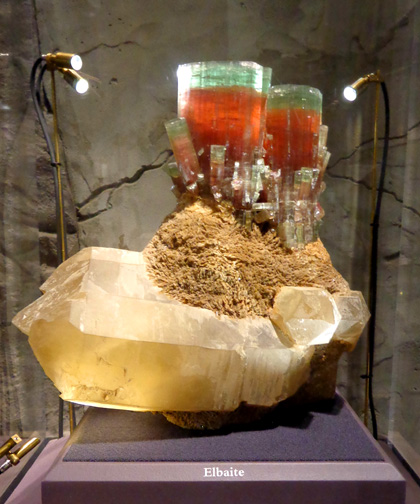
This area as so crowded, however, that it was difficult to see many of
the displays and impossible to get close enough to the Hope Diamond to photograph it.
We have to return to D.C. to get the van in the fall. If we stay in
the area long enough we plan to come back to this and maybe some other
Smithsonian museums on a weekday when there aren't so many other visitors.
Kids will be in school then.
WASHINGTON MONUMENT
This 555-foot marble obelisk built in honor of our country's first
president towers over the western part of the National Mall and
can be seen from many places in the city:
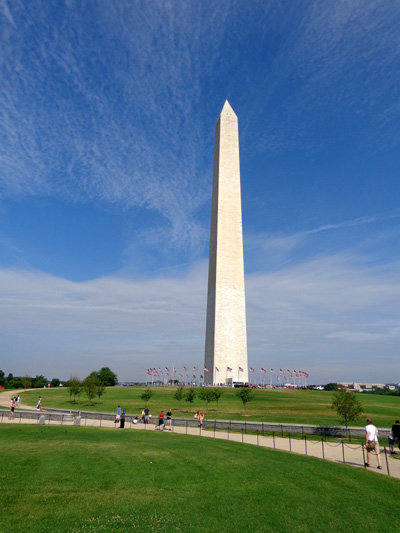
The monument was damaged in an earthquake a couple years ago but has
been repaired and reopened.
Tickets are required to tour the inside of the monument. Neither of
us has ever been inside. You can reserve tickets in advance for a fee, or
stand outside several hours for free, same-day tickets . . . and hope you can
get in that day.
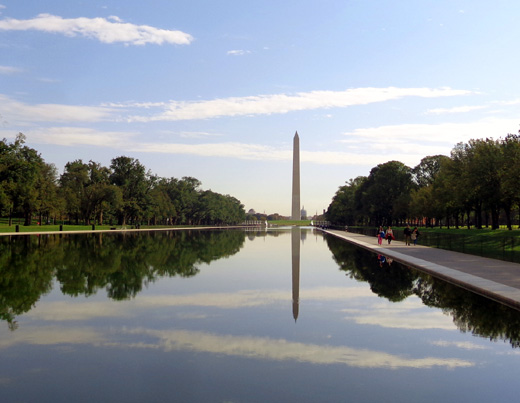
Beautiful view of the Washington
Monument as seen from the Lincoln Memorial
We still haven't been inside. By the time we called to reserve
advance tickets, the reserve-able spots were sold out. It was too hot the
two days we were at the National Mall to wait outside and maybe not even get to
go in. We may try again in the fall.
In case you're wondering, George Washington is buried on the grounds
of his home, Mt. Vernon, not the Washington Monument.
LINCOLN MEMORIAL
Nor is Abraham Lincoln buried at his majestic memorial at the far
west end of the National Mall; he was buried in his hometown of
Springfield, IL.
We've seen both his memorial and his burial site
previously so we didn't take the time this visit to go up to the top of
the steps of the memorial:
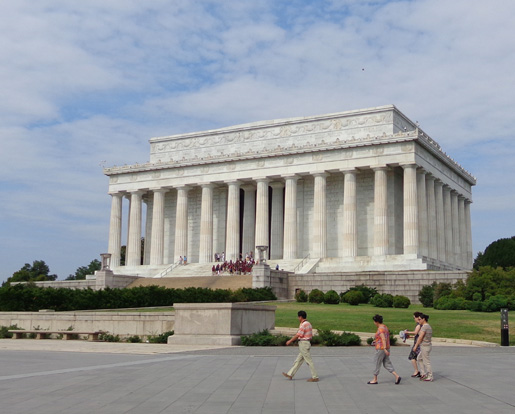
There is a very long reflecting pool in front of the Lincoln
Memorial. It's shown two photos up.
THE VIETNAM VETERANS MEMORIAL
This memorial located near the Lincoln Memorial honors the men and
women who served in the Vietnam War.
In addition to statues and informative panels about the war, a long
black marble wall contains the names of more than 58,000 Americans who
lost their lives during the conflict. The names are listed
chronologically based on when they died.

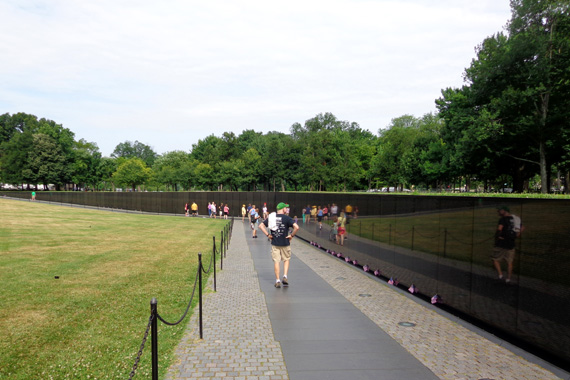
There is an index of names so visitors can find the panels they are looking for.
Jim was in Vietnam for a year (mostly during 1968) and has located
some of the names of fallen soldiers in his unit. He is always
understandably quiet when visiting this monument. It's sobering to walk
by so many, many names and know these are real people who lost their
lives in this controversial conflict.
WORLD WAR II MEMORIAL
I am totally impressed with this relatively new and very large memorial
honoring the servicemen and women who served in WWII.
It is located between the Washington and Lincoln memorials:
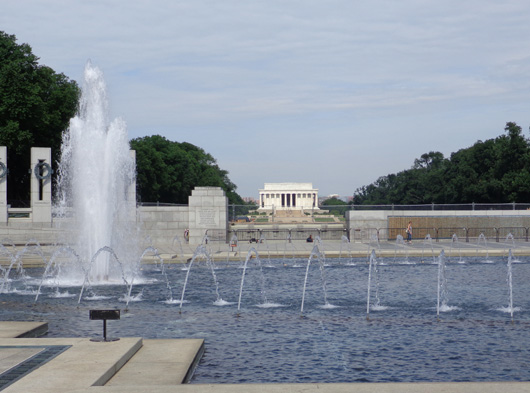
The Lincoln Memorial is in the
background.
The beautiful stone architecture, bronze panels and statues, and long pool with
fountains is a fitting tribute to all the brave men and women who risked
their lives to maintain our freedoms:
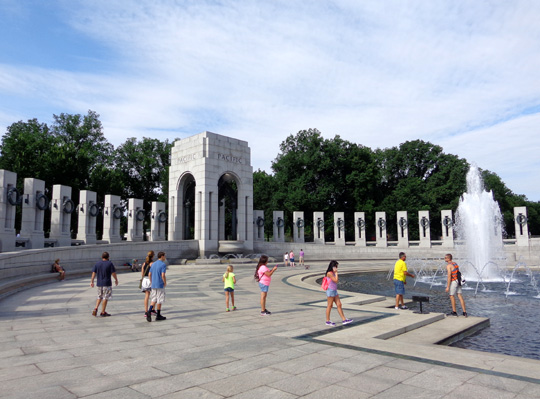
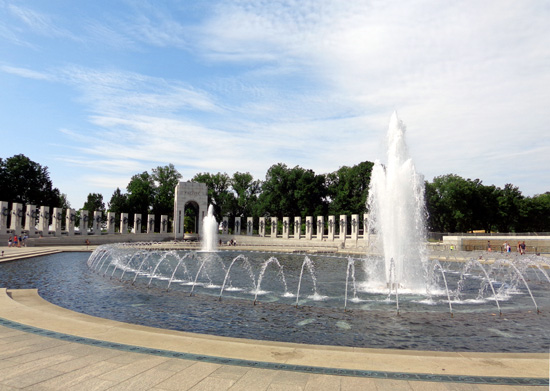
Each state (and perhaps U.S. territories??) has a column:
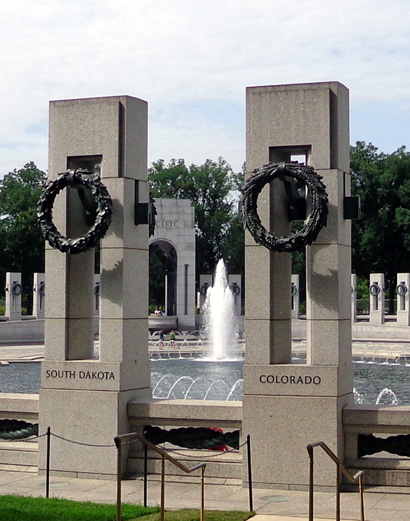
This stone structure and sculpture is at the north end
of the memorial; an identical one representing the Pacific war theater
is located on the south end:
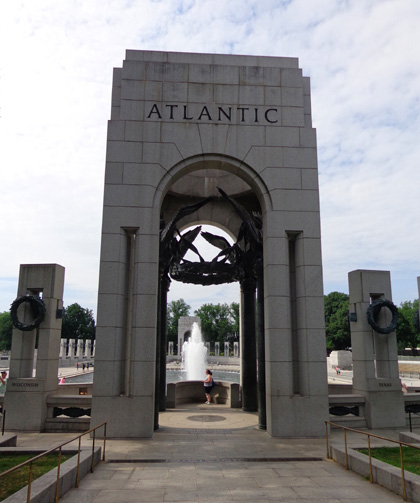
The eastern entrance to the memorial (Washington Monument side) is a
ramp down to the pool and fountains. Detailed sculptured bronze panels on
one side show the chronology of the war,
beginning with troops at home with their families before the war began
. . . through the end of the war when many returned to joyful
reunions but others came back in coffins:
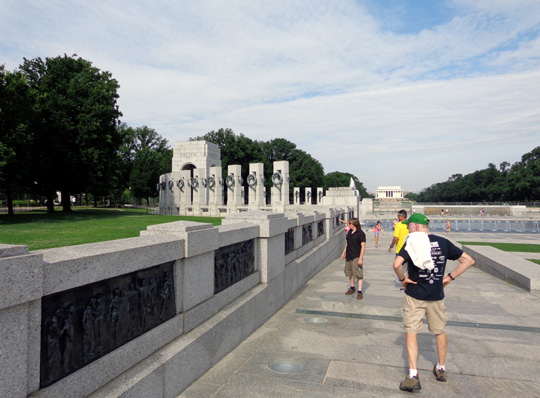
Even though I've seen the WWII memorial before I love walking through it. It just makes me proud to be an American, as do the other memorials
and monuments around the National Mall.
Next entry: a personal tour of the U.S. Capitol Building
with an enthusiastic intern from our Representative's office
Happy trails,
Sue
"Runtrails & Company" - Sue Norwood, Jim O'Neil,
Cody the ultra Lab, and Casey-pup
Previous
Next
© 2014 Sue Norwood and Jim O'Neil




































